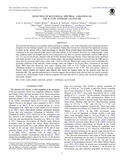| dc.contributor.author | Sanchez, Juan A. | |
| dc.contributor.author | Reddy, Vishnu | |
| dc.contributor.author | Shepard, Michael K. | |
| dc.contributor.author | Thomas, Cristina | |
| dc.contributor.author | Cloutis, Edward A. | |
| dc.contributor.author | Takir, Driss | |
| dc.contributor.author | Conrad, Albert | |
| dc.contributor.author | Kiddell, Cain | |
| dc.contributor.author | Applin, Daniel | |
| dc.date.accessioned | 2018-03-05T15:49:21Z | |
| dc.date.available | 2018-03-05T15:49:21Z | |
| dc.date.issued | 2016-12-28 | |
| dc.identifier.citation | Sanchez, J.A., V. Reddy, M.K. Shepard, C. Thomas, E.A. Cloutis, D. Takir, A. Conrad, C. Kiddell, and D. Applin. "Detection of rotational spectral variation on the M-type asteroid (16) Psyche." The Astronomical Journal 153 (1) (2017): 29 (8pp). DOI: 10.3847/1538-3881/153/1/29. | en_US |
| dc.identifier.issn | 0004-6256 | |
| dc.identifier.uri | http://hdl.handle.net/10680/1379 | |
| dc.description.abstract | The asteroid (16) Psyche is of scientific interest because it contains ∼1% of the total mass of the asteroid belt and is thought to be the remnant metallic core of a protoplanet. Radar observations have indicated the significant presence of metal on the surface with a small percentage of silicates. Prior ground-based observations showed rotational variations in the near-infrared (NIR) spectra and radar albedo of this asteroid. However, no comprehensive study that combines multi-wavelength data has been conducted so far. Here we present rotationally resolved NIR spectra (0.7–2.5 μm) of (16) Psyche obtained with the NASA Infrared Telescope Facility. These data have been combined with shape models of the asteroid for each rotation phase. Spectral band parameters extracted from the NIR spectra show that the pyroxene band center varies from ∼0.92 to 0.94 μm. Band center values were used to calculate the pyroxene chemistry of the asteroid, whose average value was found to be Fs30En65Wo5. Variations in the band depth (BD) were also observed, with values ranging from 1.0% to 1.5%. Using a new laboratory spectral
calibration method, we estimated an average orthopyroxene content of 6% ± 1%. The mass-deficit region of Psyche, which exhibits the highest radar albedo, also shows the highest value for the spectral slope and the minimum BD. The spectral characteristics of Psyche suggest that its parent body did not have the typical structure expected for a differentiated body or that the sequence of events that led to its current state was more complex than previously thought. | en_US |
| dc.description.sponsorship | This research work was supported by NASA Planetary Mission Data Analysis Program Grant NNX13AP27G, NASA NEOO Program Grant NNX12AG12G, and NASA Planetary
Geology and Geophysics Program Grant NNX11AN84G… The Arecibo Planetary Radar Program is supported by the National Aeronautics and Space Administration under Grant Nos. NNX12AF24G and NNX13AQ46G, issued through the Near Earth Object Observations program. E.A.C. thanks the Canada Foundation for Innovation, the Manitoba Research Innovations Fund, the Canadian Space Agency, the Natural Sciences and Engineering Research Council of Canada, and the University of Winnipeg for supporting the establishment and ongoing operation of the University of Winnipeg’s Planetary Spectrophotometer Facility. | |
| dc.description.uri | http://iopscience.iop.org/article/10.3847/1538-3881/153/1/29/meta | |
| dc.language.iso | en | en_US |
| dc.publisher | The Astronomical Journal | en_US |
| dc.rights | info:eu-repo/semantics/openAccess | |
| dc.subject | minor planets | en_US |
| dc.subject | asteroids: general – techniques: spectroscopic | |
| dc.title | Detection of rotational spectral variation on the M-type asteroid (16) Psyche | en_US |
| dc.type | Article | en_US |
| dc.identifier.doi | 10.3847/1538-3881/153/1/29 | |

